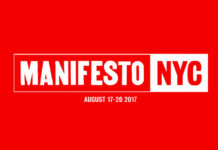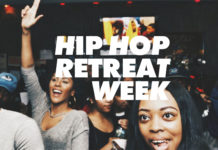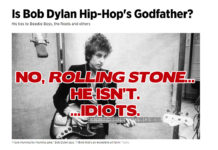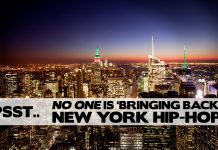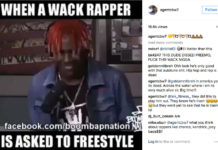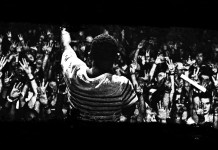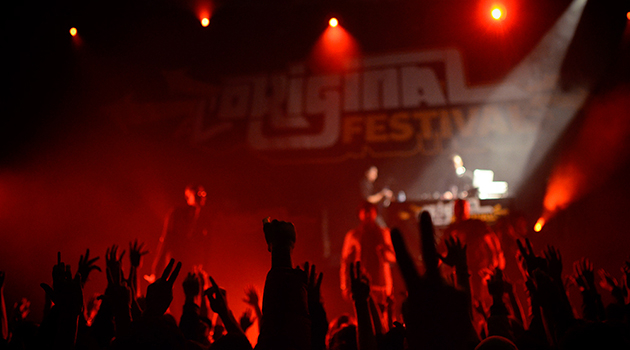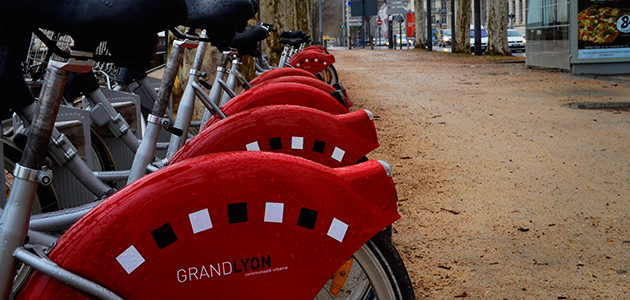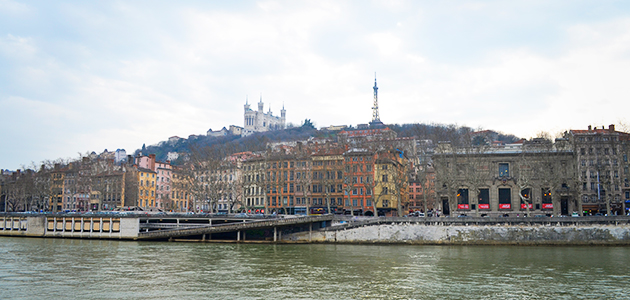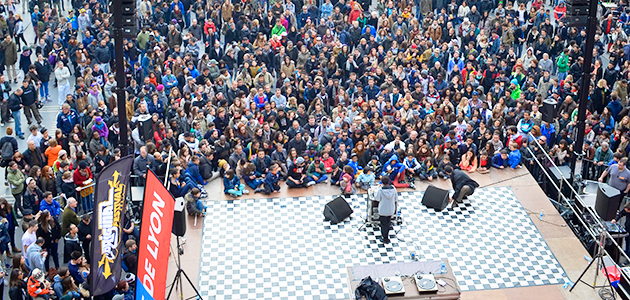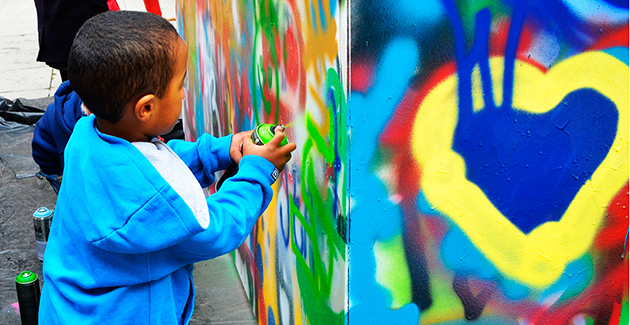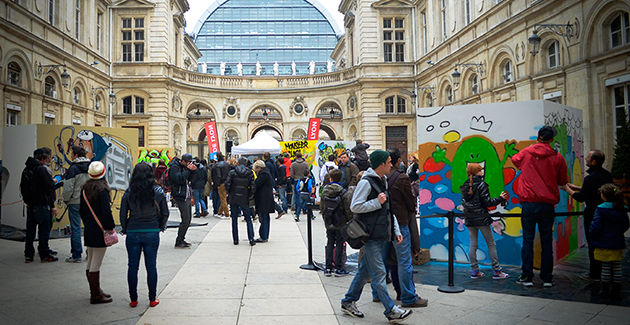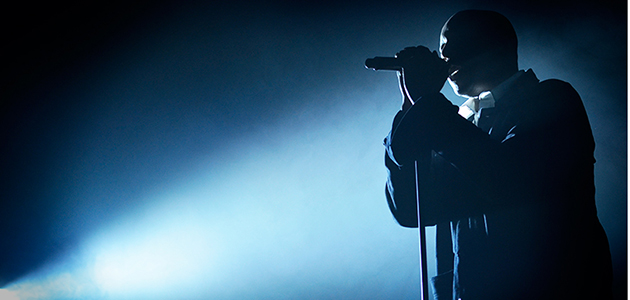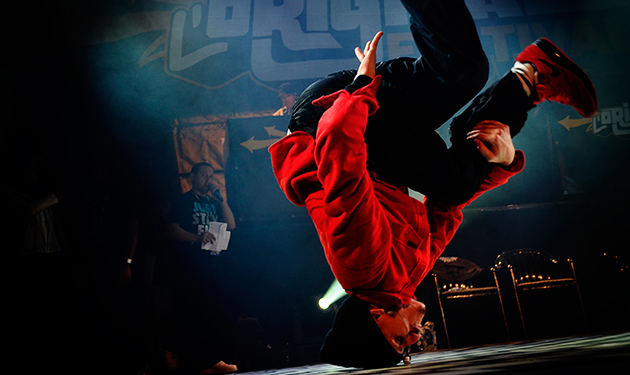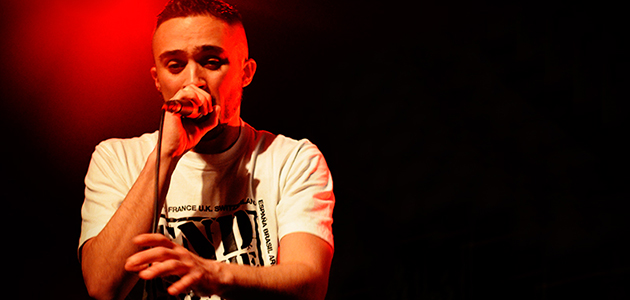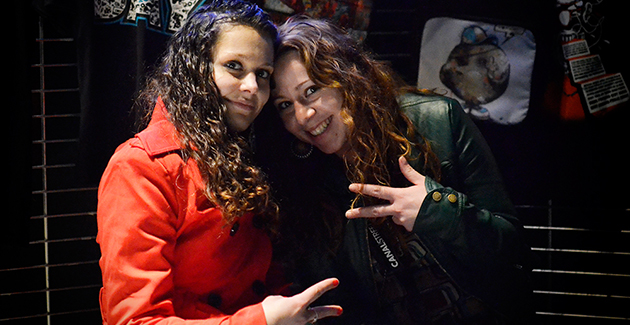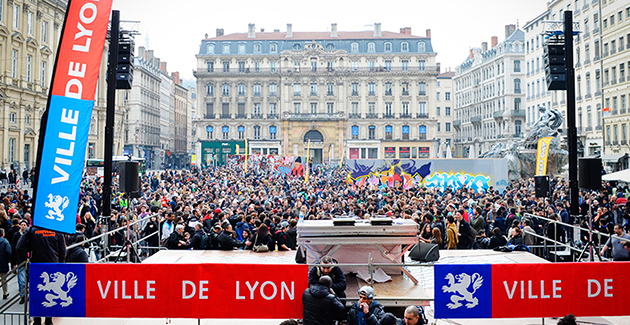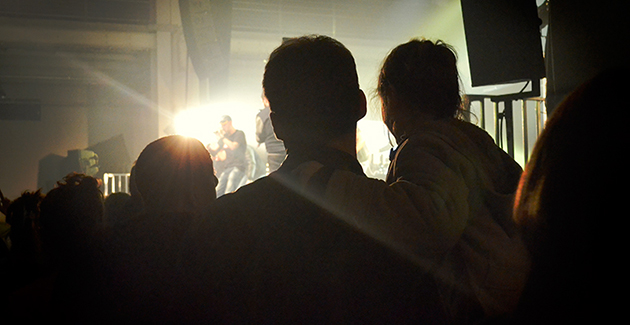It was my first time in Europe, and since hip hop brought me there, it was perhaps serendipitous that my first conversation on European soil would be with an OG graffiti artist from The Bronx.
Sonic Bad, along with fellow NY-based writers CES and Wen, had been on the same plane as I, and we shared the nearly two hour ride into Lyon from the Geneva, Switzerland airport we flew into.
Sonic was friendly and talkative, and our conversation veered throughout several topics, but never strayed far from the topic that brought us both halfway across the world.
Hip hop.
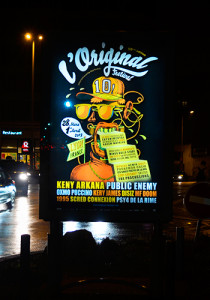 We were heading to the 10th annual L’Original Festival, an international celebration of hip hop, one that promised to be an exciting progression of events which would highlight all elements of the music and culture.
We were heading to the 10th annual L’Original Festival, an international celebration of hip hop, one that promised to be an exciting progression of events which would highlight all elements of the music and culture.
Rapping would be well represented. With an average of two major concerts per night, typically held in massive venues accompanied by intricate lighting, crisp sound systems, and hundreds, if not thousands, of gloriously excited rap fans, there would be plenty of MCing.
DJs would permeate throughout the festival, warming up shows, spinning between sets, spinning near the bar, even spinning perched on the balcony of the 17th century building which houses Lyon’s City Hall, in Place des Terreaux, a giant town square which hosted the Street Day events.
Even our hotel, the chic and trendy Mama Shelter, got into the act, sporting a playlist–fueled lobby sound system happily churning out American standards as Prince’s “Kiss,” and Deee-Lite’s “Groove is in the Heart,” along with hip hop classics like “The Symphony,” Rakim’s “Guess Who’s Back,” and Nas’ “NY State of Mind,” also arriving serendipitously, as I was sitting on the lobby computers, Facebooking an update to those back home.
The aforementioned Street Day celebration, which commandeered much of a sprawling Place des Terraraux also brought out members of the New York graffiti contingent, as Sonic, CES, Wen and a half dozen other artists would spend the day spray painting giant wooden canvases designed to simulate train cars, with thousands of French cityfolk watching as DJs and a contingent of breakdancers, held hip hop court on a warm spring day in the shadow of the Hôtel de Ville de Lyon.
Even if you didn’t speak French (I don’t) or perhaps weren’t that much into hip hop (certainly many in attendance at the Street Day were simply random passerby, drawn in purely by the spectacle), there was no shortage of beats, bombing and breaking to entertain anyone with eyes, ears and an open mind.
There were many highlights, and only a few lowlights, so for an English-speaking hip hop head from New York who has been to many music festivals, but never to Europe, visiting L’Original Festival was an amazing experience, on many levels. In the end, it was one that I would emphatically recommend to anybody who has anything above a cursory interest in hip hop.
In fact, if there was such a thing as a hip hop travel agent, L’Original Festival would easily top the list of preferred destinations. Here’s why:
THE CITY
Lyon is a beautiful city. Though I have traveled some, my experiences have been limited to beach resorts, modern Western cities and an occasional escape into nature’s boondocks. I haven’t had much experience in an “old” city, and was immediately struck by the sense of history in Lyon.
From the street layout, to the architecture, to the twin rivers and their associated esplanades, I felt a bit of reverence only felt previously while trekking among the Mayan ruins in Tulum, Mexico. A mix of solemn remembrance to what this region had to endure during times of revolution and war, and an admiration for the cultural pride and uniqueness dotting the cityscape.
Of course, one didn’t have to look far to realize this was a modern, first-world city, as large trams, resembling giant, mechanically smooth, interplanetary worms, glided through city streets. Tiny cars (nary an SUV was to be found) scurried down major thoroughfares and tight alleyways alike, and bicycle rental stations were sprinkled throughout the landscape (a system now appearing in our own New York City streets).
It was this old-to-the-new symbiosis that was the most enjoyable part of my time in Lyon, this real-time melding of eras, made particularly quaint by significant under-Americanization.
Most festival events were scheduled for evenings, so despite a chilly, drizzly first couple of days, I adventurously ventured out and about, exploring, calling on an instinct I inherited from my father, a sociologist who specialized in urban studies.
To establish a solid foundation, I learned where the grocery store was (for food and essentials, of course, but also because it doubled as a liquor store. Two birds.) I noticed several pharmacies scattered nearby, serving much more as traditional apothecaries, less like our all-purpose Duane Reades.
In fact, as I walked around, I was (pleasantly) surprised by the lack of American influence. Aside from the expected discovery of the omnipresent McDonald’s, and the not-so-expected discovery of a Dominos Pizza, there wasn’t much American brandspotting to be had.
To me, it was enjoyably surreal.
I felt like… Well… Like I was in France.
Lyon is considered the French capital of cuisine, and despite substantial time there, the festival schedule itself kept me from truly enjoying all that Lyon had to offer in this regard. I will say this. When I did eat at a restaurant, as opposed to packaged food picked up while out and about, fresh bread from the supermarket, or occasional catered food at the events, it was remarkably good, particularly (ironically?) at a Japanese-Korean restaurant tucked away on an almost-hidden side street, and at Mama Shelter’s in-house restaurant.
In both cases, délicieux!
Some of what I witnessed while traversing in and about this lovely city, helped me analyze the Lyonnaise when it came to their love for hip hop.
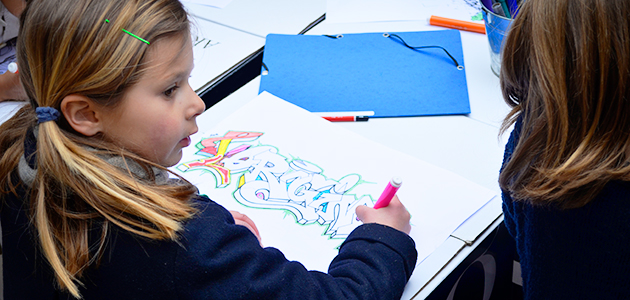
It is often said that hip hoppers outside of the United States tend to be more appreciative of the artistic nature of hip hop.
We hear that “overseas,” people are attracted to the more traditional aspects of hip hop: the original elements, a more boom-bap oriented sound, a more impassioned delivery, perhaps some good storytelling, for those who are fluent enough to follow along.
That they possess a reverence for the artistic nature of hip hop.
It is a fair assessment, at least as I observed throughout the festival. But it seems to not necessarily be born from a love and respect for hip hop in of itself, but in part, due to a general, cultural appreciation for the arts in general.
I don’t know enough about how hip hop came to be in France, whether it was associated with socio-economically suppressed communities like the South Bronx inhabitants who birthed it, but throughout the five days I was in Lyon, I never witnessed disdain for the practice of hip hop.
Obviously, this wouldn’t be expected at the shows, filled to the rafters with rap fanatics, but it was also evident at the more public events.
On Street Day for example, where hip hop took over a giant town square on what was something of an extended holiday (Easter Monday), there was a clear admiration for the abilities of the performers and artists by nearly everyone who passed though Place des Terreaux.
It was remarkably refreshing to be among people who don’t necessarily fully understand hip hop, but nevertheless stopped to enjoy and respect its associated art forms on display.
It was frankly a remarkable difference from how hip hop is treated by Americans who don’t fully understand it.
In the same vein, it was testament as to how much L’Original Festival operates with the support of the city of Lyon.
Having been to several major American music festivals (SXSW, A3C, CMJ, Brooklyn Hip-Hop Festival) I and spoken to many involved, I have witnessed varying degrees of coordination and cooperation between the events and their host cities.
I don’t have to tell anyone involved in any organizing such events, even much smaller ones, how much more difficult that cooperation can be when it involves hip hop.
However, the synergistic partnership between L’Original Festival and Lyon was refreshingly transparent and positive.
Street signs and electronic billboards throughout the city proudly advertised the festival and I observed city officials present at several of the events.
As best demonstrated by Street Day, it was clear that Lyon “gets it.”
Allowing for a major town square to be taken over, by DJs, B-Boys, rappers and graffiti artists, with DJs perched high above the crowd, spinning tunes from a centuries-old balcony, just goes to show how enjoyable hip hop can be when appreciation trumps bureaucracy.
Orchestrating such a monumental event is not easy. And though we occasionally witness similar synergy between New York City and hip hop (a fantastic case in point is this year’s SummerStage Concert Series as well as the aforementioned Brooklyn Hip-Hop Festival for example), it was hugely impressive and endearing to see the city of Lyon, as well as its inhabitants, welcome hip hop with such open arms.
To witness all elements of hip hop music and culture against the backdrop of such lovely, historical architecture, was perhaps the best example of that old-to-the-new harmony that both Lyon and L’Original Festival delivered.
THE MUSIC
If only I knew French.
I know a little bit of Spanish. My mind, when it heard someone speaking to me in French, immediately went into foreign-language-mode, but instinctively wanted me to reply in Spanish, the only foreign language I have any shot at communicating in.
Attempting to correct myself, in real time, and fumble along with pre-Kindergarten level of French, was fruitless.
For the most part, this wasn’t a big deal. I was polite and sheepish when declaring, “I’m sorry, I don’t speak French,” and most people were sympathetic and kind, shooting down any stereotype that the French look down at linguistically-limited Americans.
In fact, many would reply in English, tell me how bad their English was, then proceed to speak more fluently than a lot of New Yorkers I’ve heard speak.
When it came to the music, the bottom line is that I was simply unprepared to comprehend the lyrics. This of course put me at an extreme disadvantage, particularly when dealing with such a lyric-intensive genre as hip hop.
Interestingly, while this was a drawback, I found that, much like someone with a sensory handicap will have their other senses heightened, this language barrier actually allowed me to more fully appreciate other aspects of the performances I witnessed, which made for some fascinating analysis.
For instance, the veteran-like stage presence, commanding voice and acrobatic flow of French rap icon Oxmo Puccino was evident, and despite not knowing the meaning of the words, there was no mistaking the passion for his craft or for the messages he was relaying.
A helpful audience member informed me that Puccino was something of an elder statesman in French hip hop, one who has been performing for nearly two decades, clear from his skillful professionalism. With a perfectly coordinated light and smoke show accessorizing his delivery, Puccino’s verbal mood transformed from braggadocio to thoughtful to introspective to forceful, vividly showcasing his range.
It was enough to further investigate his work, which run a gamut of topics and styles, including descriptive works describing tough ghetto life, to later works incorporating jazz and other musical styles.
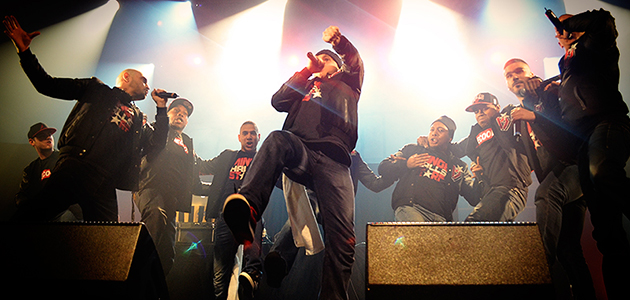
Other standouts included Ming8 Halls Starf, an opening act that I thought was worthy of top billing themselves. A collective of no less than 10 men delivered what might have been the single, most coordinated display of hip hop teamwork I have ever seen.
Each individual artist alternated between MC and hypeman, performing together as a tightly orchestrated unit, with the swagger of a Wu-Tang Clan mixed with the almost-acrobatic exuberance of a choreographed breakdance crew.
Even with the language barrier it was a hell of a show.
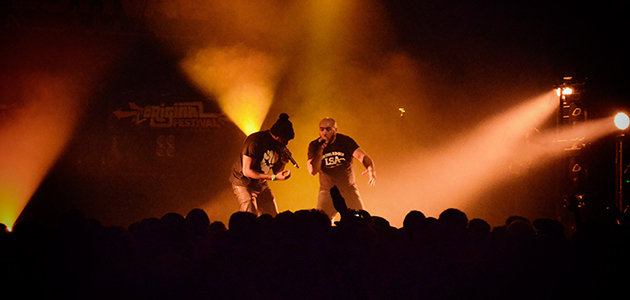
Many artists kept close to a modernized version of traditional hip hop sounds, more Boom-Bap than Trap for sure. Some, Médine for example, allowed the more popular sounds of current American mainstream hip hop to influence his production, as much of his music seemed to ride a clearly defined YMCMB/Ross/DJ Khaled vibe.
But not lyrically. Unbeknownst to me until I followed up, Médine is no molly-popping, twerk-admiring rapper. A Muslim who speaks on a multitude of political topics, any connection to trap music was purely sonic, as the depth of this artist is evident upon inspection of his catalog.
Though I was pleasantly surprised at my ability to enjoy many performances despite not knowing French, there were cases where I regretted it.
I was awaiting the climax of the Day 3 event at La Sucrière, a sprawling, warehouse-like venue, when I struck a broken-but-totally-adequate English conversation with a young lady who was eager to see the female artist Keny Arkana perform.
She shared my disappointment that I would not be able to understand her lyrical content.
“She speaks from her heart,” the woman told me, gesturing a bit to help articulate her thoughts. “She speaks to the people. She speaks to me.” The emotional connection between artist and fan was clear, and she insisted that Arkana had a lot to say.
Indeed, the Argentinean-born MC is a fiery spitress, almost intimidating in her passionately forceful delivery in songs like “Indignados,” and solemn expression during “Cinquième Soleil,” the lyrics to which, like much of her music, are deep and thoughtful, something I could only fully appreciate later upon further investigation.
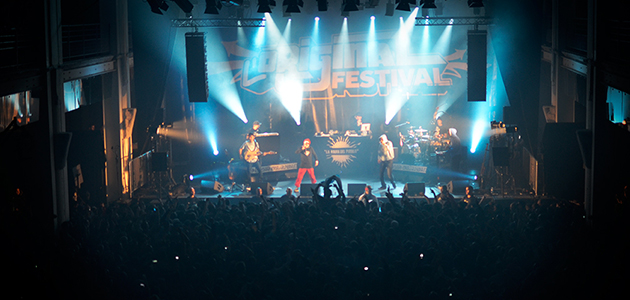
What her performance and the fan dedication I witnessed did make me think about, was the lack of female MCs on the overall bill, as well as the lack of female MCs in the U.S. limelight.
I realized how disappointing a void it must be for female hip hop fans to not have a Keny Arkana to admire and relate to. For the French, Arkana certainly fit the bill however, exuding strength, passion and a no-nonsense attitude throughout her headlining set.
There were some English speaking imports throughout the festival, so I was not always a verbal fish out of water. Colorado/L.A.-based and former Rawkus Records group The Procussions were energetic and brought some headnodding tracks with them. Skyzoo, the Brooklyn MC who I have seen on several occasions, seemed to revel in the positive attention he received from an eager crowd, putting on a furiously energetic performance with DJ Prince deftly orchestrating on the turntables.
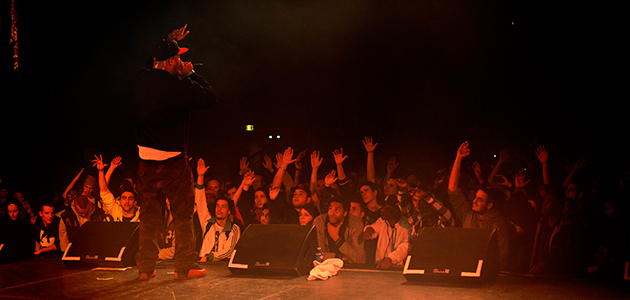
It was just the kind of test I check for when watching hometown hip hoppers outside of the boroughs. I watch to see how they fare when removed from any possible comfort zone. I was especially curious in Skyzoo’s case, as well as MF Doom who (probably?) performed earlier on the same show, as both are MCs with a heavy focus on linguistics and wordplay.
The result was pretty much the same as I felt watching the more energetic and entertainment French artists. A dope beat, a good voice, some acrobatic cadence and a receptive crowd will allow hip hop, no matter what language it’s being performed in, to thrive.
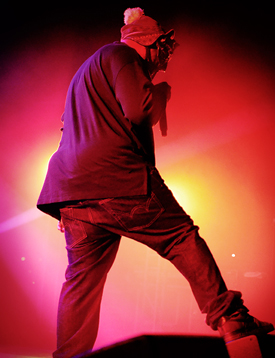
In fact, despite my lack of linguistic connection, as a hip hop head I found myself able to connect to the French-speaking artists and audience members in a way that almost transcended speech anyway.
It is a concept that encapsulates one of the best lessons I learned while in Lyon.
On my first night in France, I barely had my bearings. After a lengthy trip and a quick check in, I was off to Transbordeur for the first event. After performances by Akua Naru and Cody ChesnuTT, I was speaking to a young woman who had just watched ChestnuTT perform. She was not completely fluent in English, but again, enough to communicate. I wanted to know how she was able to enjoy his music, faced with the same language limitations I would soon be faced with while checking out French artists.
She searched for the words, finding them while circulating her hands upward and outward from her stomach, to emphasize the feeling she was trying to relay.
“He sings from his soul,” she said.
And then, profoundly, “You can see it in his eyes!”
I had never thought of it like that before.
I’ve watched a lot of shows, many up close and personal. You can tell if an artist is “feeling it,” of if they are “in the zone.” You can tell if they are connecting with their audience. You can hear it in their voice, see it in their body language. You can witness it in their smile.
But that night I learned that when someone is REALLY in their zone, it’s true. You can see it in their eyes.
It’s universal.
Until this moment, I had never really focused on the eyes.
Ever since then, I haven’t stopped.
CONCLUSION
Hip hop was alive and well in Lyon during L’Original Festival. It was more than just rapping. More than DJing. More than the image-driven, high celebrity status game of mainstream U.S. hip hop.
MUCH more than swag.
Evidence:
A midday breakdance battle delighted an all-ages audience, as toddlers, pre-teens, teenagers and their parents all stared wide-eyed at the charismatic and acrobatic displays of rhythmic, physical dance competition.
Also on the battle tip, the End of the Weak MC Challenge regional finals brought out the area’s finest verbal pugilists for a friendly, but serious microphone melee.
There were people like Flora, a sweet, energetic concertgoer who spent some time in America and who LOVES America and LOVES Chicago and LOVES hip hop and LOVES Rah Digga and LOVES to talk about it.
The helpful volunteers and interns, the stoic security guards, the frantic but never chaotic Festival staff, the Ikea-like hotel room, the fantastic sound systems and well-choreographed lighting.
There was a brunch, for families, with kids and babies (and I believe, a dog) to hang out with the members of the Pockemon Crew, a ridiculously talented dance crew.
There was Street Day, and all of it’s multi-faceted approach to representing hip hop music and culture, in all its elemental forms.
There was, surprisingly, no onslaught of wannabe MCs thrusting CDs in my face, slapping stickers on anything with a surface. No mean mugging. No beef. No fights.
This was a hip hop festival done right. This was a hip hop celebration that represented all elements of hip hop music and culture, bridged the old to the new, and stayed true to the ideals set forth so long ago in New York City.
You know. Peace, unity, love and having fun.
It was a profound reminder as to how important New York City continues to be in the grand scheme of hip hop music and culture, as the End of the Weak franchise began, and continues, in New York, while the host of the event wore both a Brooklyn Nets cap and a Freestyle Mondays T-shirt.
In all, it was at times a surreal feeling to be in the middle of a crowd of strangers, in an unfamiliar place, unable to communicate well, 3,823 miles away from friends and family and familiarity.
But thanks to L’Original Festival, and to hip hop, I still felt like I was home.
C’était magnifique.
Click here to view more photos from the
2013 L’Original Festival
Thanks to Elsa, Delphine and everyone at L’Original Festival who helped orchestrate my visit.
Special thanks to festival director JM. Your dedication to hip hop music and culture is admirable. Salute.
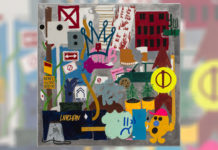
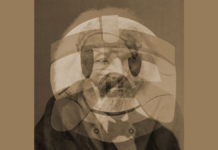
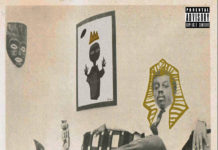
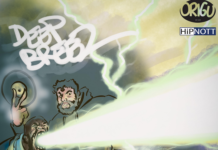
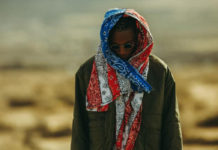
![The Underachievers – Crescendo [VIDEO]](https://www.birthplacemag.com/wp-content/uploads/2017/08/hqdefault-2-218x150.jpg)


![Fat Joe & Remy Ma ft. The-Dream – Heartbreak [VIDEO] Fat Joe Remy Ma The Dream - Heartbreak Video](https://www.birthplacemag.com/wp-content/uploads/2017/05/fat-joe-remy-ma-218x150.jpg)
![JSWISS featuring Chandanie – LML [VIDEO] JSWISS featuring Chandanie - LML [VIDEO]](https://www.birthplacemag.com/wp-content/uploads/2017/05/JSWISS-218x150.jpg)

![Akinyemi Ends Summer With “Summers” EP Release Show [9-17-17] Akinyemi 'Summers' EP release show at Brooklyn Bazaar](https://www.birthplacemag.com/wp-content/uploads/2017/09/summers-featured-218x150.jpg)
![4th Annual NYC VS EVERYBODY Yacht Party [9/16/17] #VSYacht 4th annual NYC VS Everybody Yacht Party#VSYacht](https://www.birthplacemag.com/wp-content/uploads/2017/09/vsyacht-218x150.jpg)
